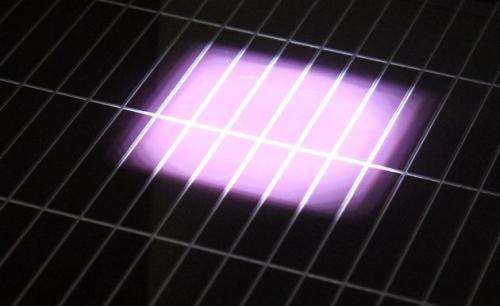Solar cell performance improves with ion-conducting polymer

Researchers at Stockholm's KTH Royal Institute of Technology have found a way to make dye-sensitized solar cells more energy-efficient and longer-lasting.
Drawing their inspiration from photosynthesis, dye-sensitized solar cells offer the promise of low-cost solar photovoltaics and – when coupled with catalysts – even the possibility of generating hydrogen and oxygen, just like plants. A study published in August could lead to more efficient and longer-lasting dye-sensitized solar cells, says one of the researchers from KTH Royal Institute of Technology in Stockholm.
A research team that included James Gardner, Assistant Professor of Photoelectrochemistry at KTH, reported the success of a new quasi-liquid, polymer-based electrolyte that increases a dye-sensitized solar cell's voltage and current, and lowers resistance between its electrodes.
The study highlights the advantages of speeding up the movement of oxidized electrolytes in a dye-sensitized solar cell, or DSSC. Also on the team from KTH were Lars Kloo, Professor of Inorganic Chemistry and researcher Muthuraaman Bhagavathi Achari.
Their research was published in the Royal Society of Chemistry's journal, Physical Chemistry Chemical Physics on August 19.
"We now have clear evidence that by adding the ion-conducting polymer to the solar cell's cobalt redox electrolyte, the transport of oxidized electrolytes is greatly enhanced," Gardner says. "The fast transport increases solar cell efficiency by 20 percent."
A dye-sensitized solar cell absorbs photons and injects electrons into the conduction band of a transparent semiconductor. This anode is actually a plate with a highly porous, thin layer of titanium dioxide that is sensitized with dyes that absorb visible light. The electrons in the semiconductor diffuse through the anode, out into the external circuit.
In the electrolyte, a cobalt complex redox shuttle acts as a catalyst, providing the internal electrical continuity between the anode and cathode. When the dye releases electrons and becomes oxidized by the titanium dioxide, the electrolyte supplies electrons to replenish the deficiency. This "resets" the dye molecules, reducing them back to their original states. As a result, the electrolyte becomes oxidized and electron-deficient and migrates toward the cathode to recovers its missing electrons. Electrons migrating through the circuit recombine with the oxidized form of the cobalt complex when they reach the cathode.
In the most efficient solar cells this transport of ions relies on acetonitrile, a low viscosity, volatile organic solvent. But in order to build a stable, commercially-viable solar cell, a low volatility solvent is used instead, usually methoxypropionitrile. The problem is that while methoxypropionitrile is more stable, it is also more viscous than acetonitrile, and it impedes the flow of ions.
But with the introduction of a new quasi-liquid, polymer-based electrolyte (containing the Co3+/Co2+ redox mediator in 3-methoxy propionitrile solvent), the research team has overcome the viscosity problem, Gardner says. At the same time, adding the ion-conducting polymer to the electrolyte maintains its low volatility. This makes it possible for the oxidized form of the cobalt complex to reach the cathode, and get reduced, faster.
Speeding up this transport is important because when slowed down, more of the cobalt complexes react with electrons in the semiconductor anode instead of with the electrons at the cathode, resulting in rapid recombination losses. Speeding up the cobalt lowers resistance and increases voltage and current in the solar cell, Gardner says.
Journal information: Physical Chemistry Chemical Physics
Provided by KTH Royal Institute of Technology




















